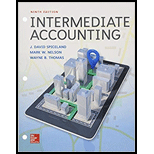
INTERMEDIATE ACCOUNTING(LL)-W/CONNECT
9th Edition
ISBN: 9781260216141
Author: SPICELAND
Publisher: MCG CUSTOM
expand_more
expand_more
format_list_bulleted
Question
Chapter 7, Problem 7.16P
(1)
To determine
Accounts receivable refer to sum of money that is received within a short period from customers upon the sale of goods and services made on credit basis. In other words, accounts receivable are the total amount that customers owe to the business. Accounts receivable is classified as an asset.
To calculate: The amount of impairment that N Bank would recognize for the L note under current GAAP.
(2)
To determine
To calculate: The amount of credit loss that N Bank would recognize for the L note.
Expert Solution & Answer
Want to see the full answer?
Check out a sample textbook solution
Students have asked these similar questions
Labour hours to complete?
Get Answer Of This Question. please Solve With General Accounting Method
Financial Accounting please answer
Chapter 7 Solutions
INTERMEDIATE ACCOUNTING(LL)-W/CONNECT
Ch. 7 - Prob. 7.1QCh. 7 - Prob. 7.2QCh. 7 - Prob. 7.3QCh. 7 - Prob. 7.4QCh. 7 - Prob. 7.5QCh. 7 - Prob. 7.6QCh. 7 - Distinguish between the gross and net methods of...Ch. 7 - Briefly explain the accounting treatment for sales...Ch. 7 - Explain the typical way companies account for...Ch. 7 - Briefly explain the difference between the income...
Ch. 7 - Prob. 7.11QCh. 7 - Is any special accounting treatment required for...Ch. 7 - Explain any possible differences between...Ch. 7 - Prob. 7.14QCh. 7 - What is meant by the discounting of a note...Ch. 7 - What are the key variables that influence a...Ch. 7 - Explain how the CECL model (introduced in ASU No....Ch. 7 - Prob. 7.18QCh. 7 - Prob. 7.19QCh. 7 - (Based on Appendix 7B) Marshall Companies, Inc.,...Ch. 7 - Prob. 7.21QCh. 7 - Prob. 7.1BECh. 7 - Prob. 7.2BECh. 7 - Prob. 7.3BECh. 7 - Cash discounts; gross method LO73 On December 28,...Ch. 7 - Prob. 7.5BECh. 7 - Sales re turns LO74 During 2018, its first year...Ch. 7 - Sales re turns LO74 Refer to the situation...Ch. 7 - Prob. 7.8BECh. 7 - Prob. 7.9BECh. 7 - Uncollectible accounts; balance sheet approach ...Ch. 7 - Uncollectible accounts; solving for unknown LO75,...Ch. 7 - Prob. 7.12BECh. 7 - Note receivable LO77 On December 1, 2018,...Ch. 7 - Long-term notes receivable LO74 On April 19,...Ch. 7 - Prob. 7.15BECh. 7 - Factoring of accounts receivable LO78 Refer to...Ch. 7 - Prob. 7.17BECh. 7 - Discounting a note LO78 On March 31, Dower...Ch. 7 - Receivables turnover LO78 Camden Hardwares credit...Ch. 7 - Prob. 7.20BECh. 7 - Prob. 7.21BECh. 7 - Impairments of Accounts Receivable Appendix 7B...Ch. 7 - Credit Losses on Accounts Receivable (CECL Model) ...Ch. 7 - Prob. 7.1ECh. 7 - Prob. 7.2ECh. 7 - Prob. 7.3ECh. 7 - Prob. 7.4ECh. 7 - Trade and cash discounts; the gross method and the...Ch. 7 - Prob. 7.6ECh. 7 - Cash discounts; the net method LO73 [This is a...Ch. 7 - Sales returns LO74 Halifax Manufacturing allows...Ch. 7 - Prob. 7.9ECh. 7 - Prob. 7.10ECh. 7 - Uncollectible accounts; allowance method; balance...Ch. 7 - Uncollectible accounts; allowance method and...Ch. 7 - Uncollectible accounts; allowance method; solving...Ch. 7 - Note receivable LO77 On June 30, 2018, the...Ch. 7 - Noninterest-bearing note receivable LO77 [This is...Ch. 7 - Long-term notes receivable LO77 On January 1,...Ch. 7 - Prob. 7.17ECh. 7 - Prob. 7.18ECh. 7 - Prob. 7.19ECh. 7 - Factoring of accounts receivable with recourse ...Ch. 7 - Factoring of accounts receivable with recourse...Ch. 7 - Discounting a note receivable LO78 Selkirk...Ch. 7 - Concepts; terminology LO71 through LO78 Listed...Ch. 7 - Receivables; transaction analysis LO73, LO75...Ch. 7 - Prob. 7.25ECh. 7 - Prob. 7.26ECh. 7 - Prob. 7.27ECh. 7 - Prob. 7.28ECh. 7 - Prob. 7.29ECh. 7 - Prob. 7.30ECh. 7 - Impairments of Notes Receivable Appendix 7B At...Ch. 7 - Prob. 7.32ECh. 7 - Prob. 7.33ECh. 7 - Prob. 7.34ECh. 7 - Uncollectible accounts; allowance method; income...Ch. 7 - Uncollectible accounts; Amdahl LO75 Real World...Ch. 7 - Bad debts; Nike, Inc. LO75 Real World Financials...Ch. 7 - Uncollectible accounts LO75, LO76 Raintree...Ch. 7 - Prob. 7.5PCh. 7 - Notes receivable; solving for unknowns LO77...Ch. 7 - Prob. 7.7PCh. 7 - Prob. 7.8PCh. 7 - Prob. 7.9PCh. 7 - Prob. 7.10PCh. 7 - Prob. 7.11PCh. 7 - Accounts and notes receivable; discounting a note...Ch. 7 - Prob. 7.13PCh. 7 - Prob. 7.14PCh. 7 - Prob. 7.15PCh. 7 - Prob. 7.16PCh. 7 - Prob. 7.17PCh. 7 - Prob. 7.1BYPCh. 7 - Prob. 7.2BYPCh. 7 - Prob. 7.3BYPCh. 7 - Real World Case 74 Sales returns; Green Mountain...Ch. 7 - Ethics Case 75 Uncollectible accounts LO75 You...Ch. 7 - Prob. 7.6BYPCh. 7 - Prob. 7.7BYPCh. 7 - Prob. 7.8BYPCh. 7 - Prob. 7.9BYPCh. 7 - Prob. 7.10BYPCh. 7 - Prob. 7.11BYPCh. 7 - Prob. 1CCTC
Knowledge Booster
Similar questions
- Explain properly all the answer this general accounting question step by steparrow_forwardIf you oppose ______, you will likely argue that ______. A. Industrial policy; governments, not the free market, should determine which sectors succeed and fail B. Anti-cabotage laws; the government doesn't need to support basic research C. Industrial policy; the free market, not governments, should determine which sectors succeed and fail D. Anti-cabotage laws; the private sector doesn't always support basic researcharrow_forwardgeneral accountingarrow_forward
- Get Answer Of This Question. please Solve With General Accounting Methodarrow_forwardFinancial statements are prepared from the balances in a(n) ________. A. Unadjusted trial balance B. Adjusted trial balance C. Chart of accounts D. General journalarrow_forwardPlease provide correct answer this financial accounting questionarrow_forward
arrow_back_ios
SEE MORE QUESTIONS
arrow_forward_ios
Recommended textbooks for you
 Intermediate Accounting: Reporting And AnalysisAccountingISBN:9781337788281Author:James M. Wahlen, Jefferson P. Jones, Donald PagachPublisher:Cengage Learning
Intermediate Accounting: Reporting And AnalysisAccountingISBN:9781337788281Author:James M. Wahlen, Jefferson P. Jones, Donald PagachPublisher:Cengage Learning

Intermediate Accounting: Reporting And Analysis
Accounting
ISBN:9781337788281
Author:James M. Wahlen, Jefferson P. Jones, Donald Pagach
Publisher:Cengage Learning